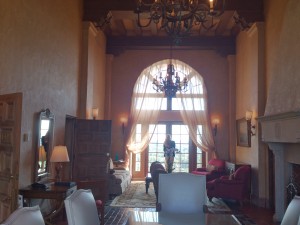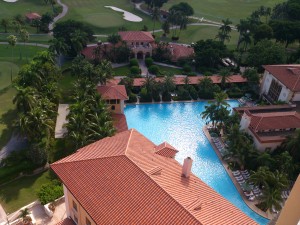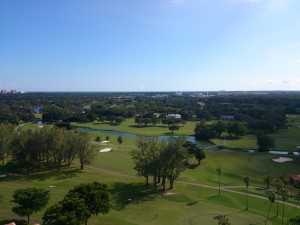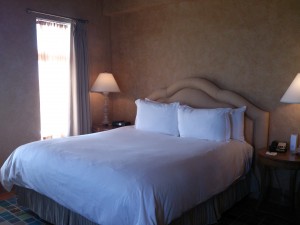Posted on November 8, 2013
By PATRICK RILEY
Deep in the heart of Coral Gables, the “The City Beautiful,” there lies a structure so imposing in nature and aesthetically pleasing in design that one cannot help but to be somewhat awestruck upon encountering it for the first time.

The Biltmore’s Merrick Suite occupies the entire floor of the tower and features expansive views, two balconies, living room, a dining area for six guests and a fireplace (Photo by Patrick Riley).
With its soaring tower, intricate ornaments and playful fountains, it resembles a cross between a royal Spanish palace and a castle the likes one can only find in Disney World.
This noble edifice serves as a world-renowned hotel and is known by a name that has been in high regard ever since its grand opening more than 80 years ago.
They call it the Biltmore.
But while this fabulous harborage for the haut monde is undoubtedly a feast for one’s eyes, more importantly, it is a historical landmark that has stood the test of time and witnessed its surroundings transform into the flourishing City of Coral Gables we know today. Its beginnings , however, were humble, if only marginally.
“The hotel was originally built in 1926 and it was built as more of a country club atmosphere though it was a hotel as well,” explained Raley Ewing, public relations coordinator for the hotel. “The golf course was built first so you’ll see a lot of pictures around the property of people using the golf course and the country club atmosphere there and then staying in the hotel once the hotel was built.”
The engineer of this $10 million mammoth project was George E. Merrick, who joined forces with Biltmore hotel magnate John McEntee Bowman to capitalize on Florida’s land boom of the 1920s. Merrick, the mastermind behind Coral Gables itself, wanted to make the Biltmore the centerpiece of his elegant, stately suburb and his love for Italian, Moorish and Spanish architecture greatly influenced his project.
Finally, on Jan. 14, 1926, the hotel officially opened its doors for the first time and a crowd of 1,500 guests celebrated the debut as the Giralda Tower – which was modeled after one of Merrick’s favorite landmarks, a tower by the same name in Seville, Spain – was lit for the first time. It became clear from the start that this would henceforth be a place where the rich and famous would rub shoulders, some notorious, others obscure.

The Biltmore’s 23,000 square foot pool was once used as a venue for aquatic shows (Photo by Patrick Riley).
“The Biltmore has been an icon since it opened,” Ewing said. “So, you mentioned Al Capone, there are a few legends that go around about him. We’re not exactly sure how many of them are true, but we do know that he frequented here. It was his favorite place to be. We don’t know necessarily which rooms he used or what he did here but, he did come here a lot.
“Tarzan, yeah. He worked as a l
ifeguard here. That was before he was Tarzan obviously.”
Of course, not all guests at the Biltmore were infamous mobsters or vine-swinging movie stars. Some were just your regular presidents of the United States of America.
Like Franklin D. Roosevelt, for instance, who enjoyed South Florida and the Biltmore so much so that he had a temporary White House office set up in the hotel.
“It is a regular room now,” Ewing said. “The one that he used was not a guest room at the time. As I understand it, the space was occupied as both a cellar/club bar and a lounge area. And off to the side of that, he utilized the space for a private office. He wasn’t here all the time. He just came and used this whenever he was in town. It was more or less of a secretive thing, because it was for that reason. He wanted to be private. He wanted to have some space where he was out of the public eye.”
The hotel, on the other hand, remained in the public’s eye and enjoyed a great deal of popularity. Fashion shows, gala balls, aquatic shows in the 23,000 square foot pool, weddings and world-class golf tournaments further contributed to the onrush of stars and wannabe celebrities.
“Back in the day, they actually built a structure over the pool and it was in the form of a catwalk and then they also had stadium seating around the pool,” Ewing explained. “So you’d actually have thousands and thousands of people sitting on what is now our pool, on a structure built over the pool, so that these models could walk the catwalk over the pool.”
Eventually, though, even the most illustrious eras had to make way to a more sobering one: World War II.
“World War II happened and the hotel was actually doing pretty well at the time,” Ewing said, “but the National War Convention had to utilize the hotel as a hospital because the space was limited in the city and they needed a big building like this where they could have any number of medical care staff and patients.
“They shut it down as a hotel, used it as a hospital – that was until the war ended. Now when the war ended, it actually continued to be used as a hospital, but for veterans.”
What followed next was a prolonged period of abandonment that reached into the early 1980s. It is highly likely that the accounts of the hotel being haunted stem from this era of desolation.
“I can’t confirm or deny if the hotel is haunted,” Ewing said. “But I have heard people tell me stories and I’ve heard people’s renditions of certain strange things that happened here. […], I knew a girl that worked overnight at the front desk and she had a few interesting experiences in the middle of the night. […] Somebody, an appearance of some sort, in the lobby. She swears by it 100 percent so, you know, I haven’t ever experienced anything so I can’t tell you yes or no, but [it] depends on what you think.”
Eventually, notwithstanding the possibility of unwanted ghosts, the City of Coral Gables purchased the building in 1973, but continued to leave it unoccupied for almost 10 years.
Numerous renovations and millions of dollars later, the hotel was entrusted to a Florida hotel management firm, called Seaway Hotels Corp., and resumed operations for good in June 1992.
And while fine cuisine, impeccable service and amenities that range from a lavish spa to a massive golf course have once again made the hotel the abode of choice for the deep-pocketed (room rates range anywhere from $180 to $7,000 a night depending on the season), the real appeal of this hotel is its rich history. A history so fantastic its tales have even reached the Old World.
Just ask Eric Guineau from France.
“It’s just incredible,” he said. “I heard Al Capone stayed here. So be careful with the ghosts.”
If You Go
- Reservations
Telephone: 855-311-6903
Fax: 305-913-3158
E-mail: reservations@biltmorehotel.com - General inquiries
Telephone: 855-311-6903
Fax: 305-913-3110
E-mail: general@biltmorehotel.com - Concierge
Email: BiltmoreConcierge@biltmorehotel.com - Dining reservations
Main reservations: 305-913-3200 - Tours
There are free tours on Sundays at 1:30 p.m. and 2:30 p.m. that showcase the property and explain the history of the Biltmore. If rooms are available, those are displayed as well.


